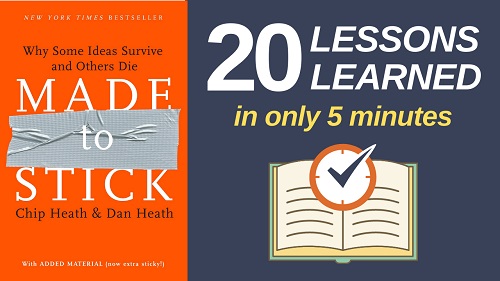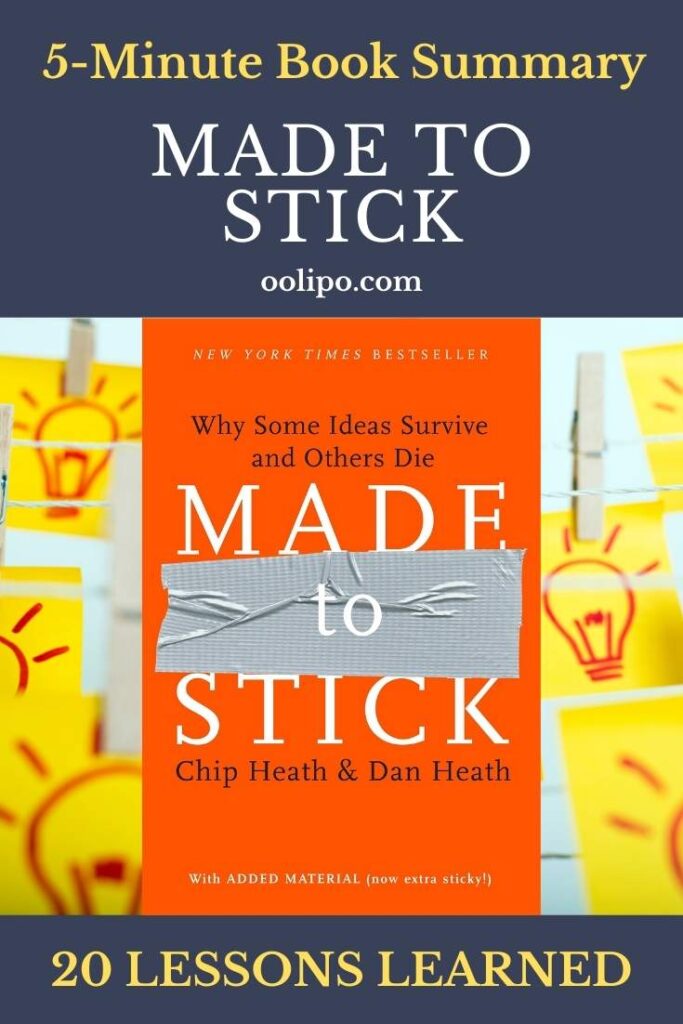Made to Stick: Why Some Ideas Survive and Others Die is a book written by Dan and Chip Heath brothers in 2007. In this Made to Stick summary, we will dive deep into the Heath brothers’ perspective on creative ideas and entrepreneurship.
While some ideas are very good, they are forgotten, while others remain in our minds for years. You can learn how these sticky ideas used in all areas of life work in detail from Dan and Chip.

Made to Stick Summary with 20 Lessons Learned
Here are the 20 lessons to learn from Made to Stick Summary:
#1 Characteristics of Sticky Ideas
In the book, it is said that there are 6 basic characteristics of sticky ideas. Simple – Unexpected – Concrete – Credible – Emotional – Stories. As can be understood from its initials, SUCCES emerges in this way.
#2 Simple
For an idea to be sticky, it has to be understandable by more people. Since we are not talking about academic information, do not turn people away from your idea from the very beginning by generating complex ideas. Reduce it to simple expressions. If you cannot explain your idea simply, you may not have understood the subject completely.
#3 Unexpected
Familiar ideas stay in our minds but do not interest us. Ideas that will excite us and haunt us should be unexpected ones. An idea that everyone thinks does not attract us. Just because it’s unexpected doesn’t mean it will be difficult. Sometimes surprising ideas are right in front of us, but it may take time to see.
#4 Concrete
People can’t adopt abstract ideas very much, but if you manage to embody them somehow, it starts to turn into a permanent and sticky idea. For this, you need to improve your descriptive ability.
#5 Credible
When you present exaggerated ideas, people feel cheated. Even if what you say is true, don’t say it in the first place. If you can prove it and explain it nicely, take that risk. Don’t expect a second chance from people after you’ve lost their trust.
#6 Emotional
You have to come up with ideas that, when spoken, arouse feelings of desire or fear in people. If the idea is associated with an emotion, every time people feel that emotion, they think of the idea you presented to them. It’s like the taste of chocolate you eat suddenly takes you to a memory you had as a child.
#7 Story
If you want to keep any topic in mind, making it a story is the best method. We also use this method when generating sticky ideas. By associating our idea with a story, we ensure its permanence.
#8 Unknowns
The human mind does not like spaces. Skip a particular part of your idea. Arouse people’s curiosity. They will think about when the topic will come to the part you skipped. To find out, they will ask you questions and be drawn into your mind.
#9 Characteristics of the Story
You should tell a story in as motivating a style as possible. Listeners should be deeply impressed by the struggle of the hero of the story. Maybe they put themselves in that hero’s shoes. Such a situation ensures that your idea is adopted.
#10 Empathy
The hero of your story should exhibit exemplary behavior. He must truly understand the people he is helping. A hero who just solves the problem and walks out isn’t attractive to anyone. Our hero must be sensitive.
#11 Creativity
People may have similar problems, but they want to work with a company that produces innovative solutions instead of any of the 100 companies that offer the same solution. People who are bored of doing the same things over and over will prefer you and will talk about you as their discovery.
#12 Inform First
People who have no background in the idea you are going to tell will look at you with empty eyes. In order not to appear ignorant, they will pretend to understand and will not discuss this idea with you again. Be aware of who you are presenting your opinion too.
#13 Putting In The Effort
Even if you find the best idea in the world, that idea will not spread if it is not expressed correctly. You should work on that idea and make it available to the audience by analyzing it. Do not try to present the first idea that comes to your mind to people.
#14 After You Have Your Opinion
You made your preparations, met with the audience, and presented your idea. So far, everything may have gone as you planned, but from here on, the real struggle is the part. Questions will begin to come from the audience. There will be questions that you haven’t thought of before. If you have answers to these, it means that your idea will be carried to the next stage.
#15 Imagination
Storytelling is a skill that can be developed. You can unleash this talent with various training. While expressing your opinion, you should aspire to storytelling as much as possible. The better a storyteller you are, the more you can spark the audience’s imagination.
#16 Muses
Don’t wait for inspiration. Because it won’t come. You will work long hours in the field where you want to find ideas. You will read books in that field and examine previous projects. There is no miracle other than work.
#17 I Can’t Think Of Ideas
If you don’t have any ideas, it’s time to stop thinking about it. Now is the time to focus on other things, maybe take a walk. The harder you push yourself, the less likely you are to come up with an idea.
#18 Different Areas
You must have basic knowledge in different fields to generate ideas. As you gain knowledge, you can connect topics and come up with interesting ideas. If you only stick to the content in your field, you will have difficulty generating original ideas.
#19 Questions
If there is no excitement on the other side when you express your opinion, or if you do not ask questions even if they are critical, it means that you have not attracted anyone’s attention. Now go back to your work and continue working on the idea.
#20 Changes
Your idea will not remain as it was originally conceived and presented. It will be updated many times until it reaches the production stage. The result in the final may be a little surprising. The important thing is that you lit the first fire. If it weren’t for you, things wouldn’t have gotten to this point.
Top 10 Quotes from Made to Stick
1. “How do we find the essential core of our ideas? A successful defense lawyer says, “If you argue ten points, even if each is a good point when they get back to the jury room they won’t remember any.” To strip an idea down to its core, we must be masters of exclusion. We must relentlessly prioritize.”
2. “The inverted pyramid also allows newspapers to get out the door on time. Suppose a late-breaking story forces editors to steal space from other stories. Without the inverted pyramid, they’d be forced to do a slow, careful editing job on all the other articles, trimming a word here or a phrase there.”
3. “At one level, the idea of compactness is uncontroversial. Rarely will you get advice to make your communications lengthy and convoluted unless you write interest-rate disclosures for a credit card company? We know that sentences are better than paragraphs. Two bullet points are better than five. Easy words are better than hard words. It’s a bandwidth issue: The more we reduce the amount of information in an idea, the stickier it will be.”
4. “Psychologists define the schema as a collection of generic properties of a concept or category. Schemas consist of lots of prerecorded information stored in our memories. If someone tells you that she saw a great new sports car, a picture immediately springs to mind, filled with generic properties. You know what “sports cars” are like. You picture something small and two-door, with a convertible top perhaps. If the car in your picture moves, it moves fast. Its color is almost certainly red.”
5. “Imagine investing millions in an idea that will change as it is filtered through the consciousness of a succession of individuals with giant egos: directors, stars, producers, marketers. That idea had better be good.”
6. “The most basic way to get someone’s attention is this: Break a pattern. Humans adapt incredibly quickly to consistent patterns. Consistent sensory stimulation makes us tune out: Think of the hum of an air conditioner, or traffic noise, or the smell of a candle, or the sight of a bookshelf. We may become consciously aware of these things only when something changes: The air conditioner shuts off. Your spouse rearranges the books.”
7. “Unexpected ideas are more likely to stick because surprise makes us pay attention and think. That extra attention and thinking sear unexpected events into our memories. Surprise gets our attention.”
8. “The vision of a pocketable radio sustained a company through a tricky period of growth and led it to become an internationally recognized player in technology. The vision of a man on the moon sustained tens of thousands of separate individuals, in dozens of organizations, for almost a decade. These are big, powerful, sticky ideas.”
9. “Medically, the story related above teaches important lessons. It instructs people in how to spot and treat the specific condition pneumopericardium. More broadly, it warns medical personnel about relying too much on machines. The heart monitor was functioning perfectly well, but it couldn’t substitute for the insight of a human being with a simple stethoscope.”
10. “It’s easy for a doctor to treat appendicitis once it’s been diagnosed, but the problem is learning to distinguish an inflamed appendix from an upset stomach or food poisoning or an ulcer. Or think about beginning algebra students, who can solve complex equations but grind to a halt when they’re presented with a simple word problem that involves exactly the same math. Problem X doesn’t always identify itself as Problem X.”
Free PDF Download of Made to Stick Summary to Save or Print
We created a PDF file with the summary and quotes on this page for easy access: Download Made to Stick PDF Summary. If you want to buy the paperback version of the book, check out this page.
Animated Summary
Please share these important lessons by pinning this post to Pinterest.
